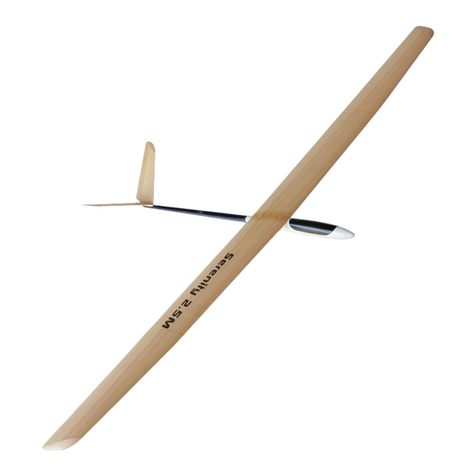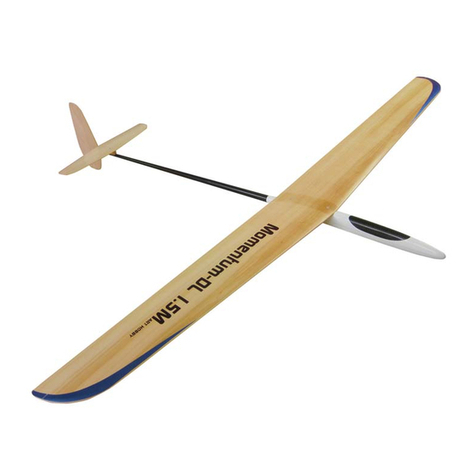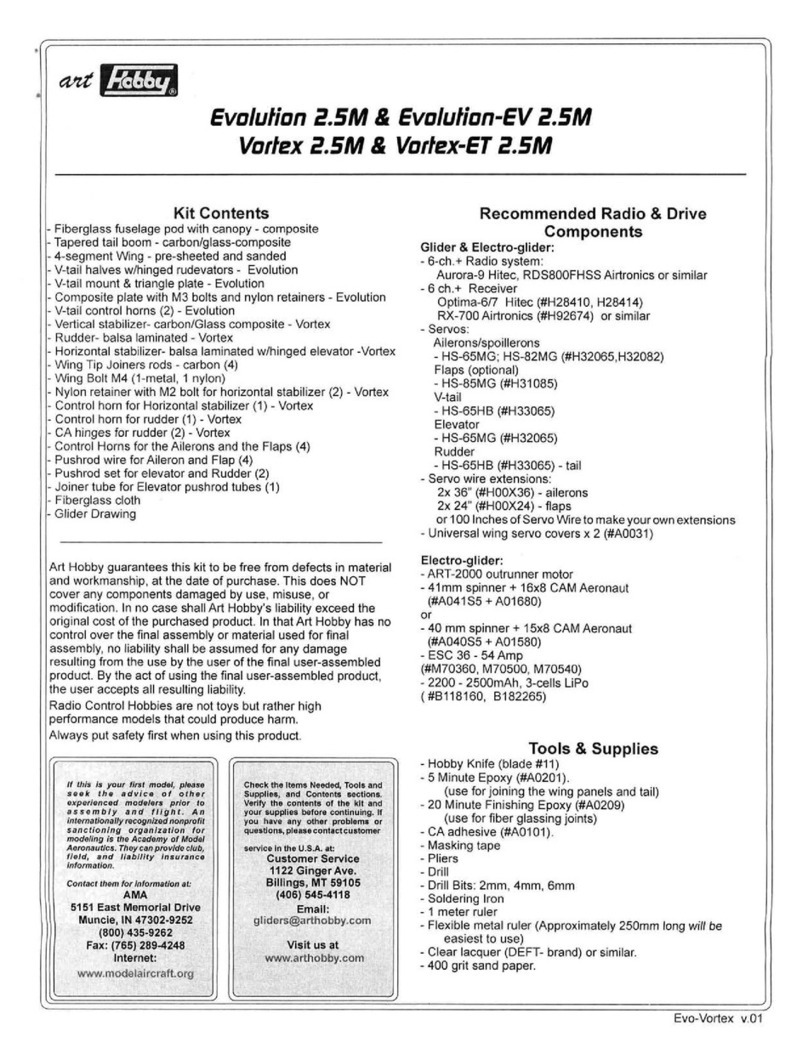
Wing Installation
The wing is bolted to the fuselage with three 5mm nylon bolts
and blind nuts. The bolts are inserted through the hardwood
blocks in the wing. It is important that the wing bolts are posi-
tioned through the middle of the blocks. It is also important to
properly glue the plywood plates securely inside the fuselage.
Please thoroughly read through this section before beginning
assembly.
1. Find the wing, fuselage, nylon wing bolts, and plywood plates.
2. Mark the bolt hole positions on the top of the wing. The holes
should be positioned 15mm from the wing root, and should be
centered over the block. To check your work, measure the distance
between the holes (from front to back).The holes should be 150mm
apart.
3. Through the WING ONLY, use the marks you made as a guide to
drill 5mm diameter holes for the wing bolts. The holes should be
drilled perpendicular to the top of the wing.
4. Test fit the wing on the fuselage. It should be leve on the fuselage
and perpendicular (90 degrees) to the fuselage centerline.
5. Mark the hole position on the fuselage wing saddle for the wing
bolts. By marking the holes to match the holes you just drilled, you
are assured a perfect match.
6. Open an acess hole on the top of the wing saddle. The hole
should be 40mm wide and 90mm long. Center the hole between
the screw positions. We suggest using a rotary tool and a sanding
drum to make the hole.
7. Double check the hole positions on the fuselage.
Open the holes with a 5mm drill bit.
8. Insert the wing bolts into the wing and place the wing on the
fuselage. Check that the wing is now properly centered on the
fuselage.
9. Locate the two plywood plates. These plates will support the
blind nuts in the fuselage.
10. Trim the edge of the plate to fit under the wing saddle.Test fit the
plates in the fuselage.
11. Glue the plates in position with 5 minute epoxy.
12. Once the glue dries, use a 7mm drill bit to open the holes for the
blind nuts.
13. Insert the blind nuts. Install the wing bolts (with the wing in
position).
14. To set the blind nuts in position, glue them in place with epoxy.
4.
Tow Hook Installation
1. If you have decided to install the towhook, you will need a 4mm
blind nut and 1/4 inch 5 ply plywood, 3/4 inch wide by 3 inches
long.
2. The Towhook is located 63mm behind the wing’s leading edge.
3. Shape the 1/4 inch plywood strip to match the fuselage curves.
4. Install the plywood over the towhook position (inside the fuse-
lage) with a generous portion of 5 minute epoxy.
5. Once the glue has set, drill a 4mm hole for the towhook.
6. Open the hole in the plywood for the blind nut.
7. Install the blind nut and the towhook.
Wing Servo and Control
Surface Installation
Refer to glider drawing and check the marking of the aileron and
flap location on each wing.
1. Cut the aileron and flap from the wing.
First cut both ends of each aileron and flap. We recommend using
a fine balsa saw to make those cuts. Use hobby knife with #11
blade and metal ruler as a cutting guide to cut the ailerons and
flaps from the wing.
It is very important to make perfectly straight cuts.
2. Because the ailerons will be hinged on the upper wing surface,
the leading edge of each aileron will need to be sanded at an
angle to allow the aileron to deflect down.
The flaps will be hinged on the lower wing surface.
3. Use hinge tape (or silicone hing) to attach the ailerons and flaps
to the wing.
4. The wing flap servo bays 40mm x 35mm are located 320mm in
from the wing root, and 100mm from the trailing edge.
5. The wing aileron servo bays 40mm x 35mm are located 775mm
in from the wing root, and 90mm from the trailing edge. Please use
Hitec HS-85 servos for the ailerons, and HS-85MG servos for the
flaps or similar wing servos. Make an exact cut in the bottom of the
wing for the servos. Align the servo so that the output arm is aligned
with the aileron or flap.
6. Run servo wire through the wing (music wire can be used to help
pull the wire through) Hardwire the servo wire extension to the
servo. There is simply no room for the servo plug. Be very careful to
keep the polarity correct and each wire insulated.
7. Connect the servos to the receiver. Turn on the radio and center
the servos. Check for proper servo movement - use servo reversing
switches on the transmitter if the servo turn in the wrong direction.
8. Install control horns on the ailerons and flaps directly back from
the servo arm. The horns should be positioned with the holes for-
ward and aligned over the hinge line. Use a small dab of epoxy or
CA to permanently secure the horns in position.
9. Place the servos in the center of servo bays, lock the ailerons
and flaps in a neutral position securing both ends of each control
surface to the wing’s trailing edge with a piece of tape.
PHOTO 9
SierraS v.03
Now measure distances between servo control arms and aileron,
and also the flap control horns, according to these measurments
make two sets of short pushrods from the supplied wire (we sug-
gest making “Z” bend on both ends).
10. Connect the pushrods first to the aileron and flap horns, then to
the servo arms, after that install the servos in servo bays with a
small amount of silicone sealer.
11. To cover the servos you can use Art Hobby’s universal wing
servo covers (#A0031) PHOTO 9
(change new the towel if needed)
16. Repeat steps 11-14 and apply reinforcing cloth to the top of the
joint.
17. Once the epoxy has set, remove the masking tape.
Apply fresh masking tape 2mm past the end of epoxy.
18. Use 400 grid sand paper and sand the joint smooth if needed.
Do NOT sand away the wingsheeting where the glass ends.
This will weaken the wing and could cause failure.


























